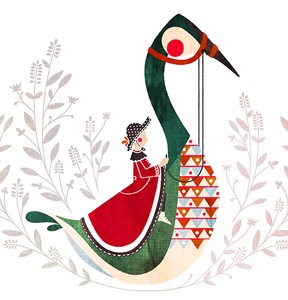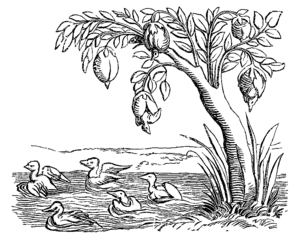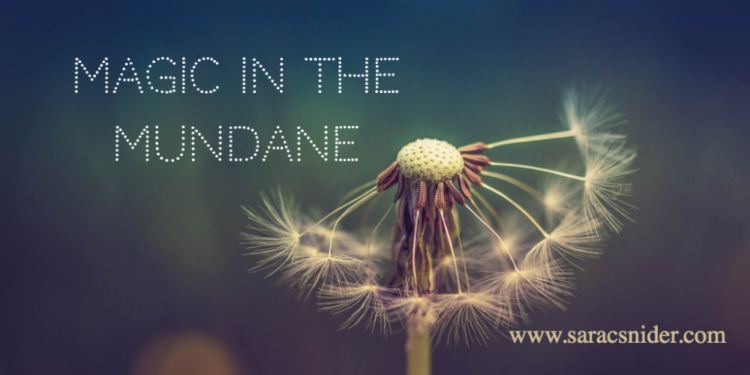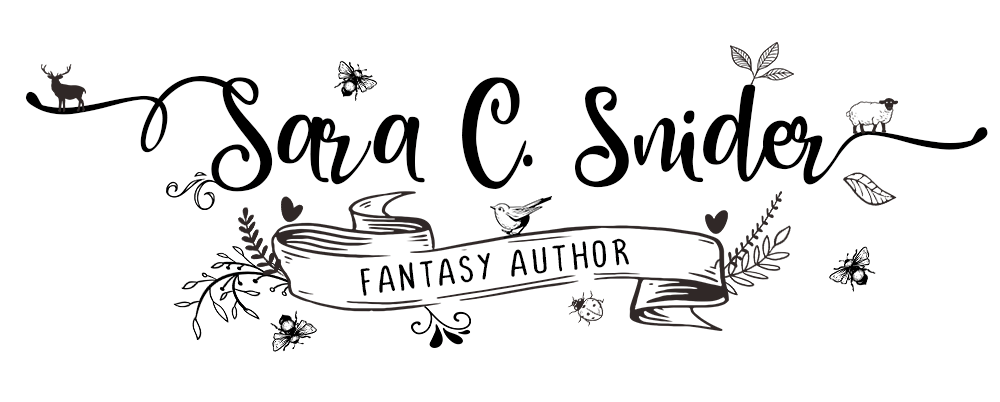Summer has come and gone in a bit of a haze for us. Remember back when we bought a plot? Well, we’re planning on building a house to go on that plot, and there’s about five billion different decisions to be made on just about everything. So that was my summer. Deciding on door handles, door styles, faucets, sinks, etc. It’s pretty exciting, but it’s also overwhelming and kind of scary.
So that means it’s time for some magic.

Golden Geese
Not gold as in metal, but as in the sun. Geese are both a symbol of the sun and, consequently, a fertility symbol. Given what we’ve learned about the egg, I don’t think that comes as a huge surprise, and there is some overlap. In Egyptian mythology, the world was created when the Nile goose laid an egg from which the sun hatched.
This relation geese have to the sun and fertility seems to be connected to migration. It was (and still is) quite a sight to behold flocks of geese flying overhead. When the geese returned in the Spring along with the lengthening, warming days, it signaled a renewal of life. It makes sense that geese were associated with the sun (and sun god)—the power responsible for such a renewal.
A Gaggle of Mother Geese
So, I wasn’t going to write about Mother Goose because, you know, too obvious. But when I read about the Indian God Brahma and Greek Goddess Aphrodite being depicted riding a goose (and also Nils Holgersson—thanks Anders for that bit of Swedish culture), it got me curious about Mother Goose and where she came from. What’s her significance? Turns out it’s more interesting than I thought.
 It’s theorized that the origin of the moniker “Mother Goose” dates back as far to the 8th century to Charlemagne’s mom, Bertrada II of Laon. She was a patroness of children who was also known as “Goose-foot Bertha” or “Queen Goosefoot” due to a malformation of one of her feet. If this is true, then Bertrada was in good company.
It’s theorized that the origin of the moniker “Mother Goose” dates back as far to the 8th century to Charlemagne’s mom, Bertrada II of Laon. She was a patroness of children who was also known as “Goose-foot Bertha” or “Queen Goosefoot” due to a malformation of one of her feet. If this is true, then Bertrada was in good company.
Freya, the badass Norse goddess who rides around in a chariot pulled by cats is sometimes depicted as having one human foot and one of a goose or swan. The Germanic goddess-turned-witch Berchta also had one foot of a goose. (FYI, her mode of transportation was riding the back of storms.) Queen Sheba apparently had a goose foot, along with a number of Christian saints.
Why these women are portrayed with having the foot of a goose is not clear, unfortunately. Terri Windling states that it has shamanic significance in various cultures, though I couldn’t find what that was. Phillipe Walter explains that the goose foot is an ancient sign of transformation, carried over from pagan goddesses who had the ability to transform into birds—such as the Celtic Morgana. Rather than disappearing entirely when Christianity took over, these women were reimagined as saints (or in the case of Berchta, a witch) with the goose foot remaining as a vestige of their previous power. Yet in the Christian context it can take on new meaning. For example, saint Neomaye, when forced to marry a man against her will, asked that her foot be transformed into that of a goose, thus rendering her undesirable.
So was Mother Goose a pagan goddess capable of transformation? Probably not, but it makes me smile imagining that she was.
Geese: the other shellfish
The Barnacle Goose, commonly seen around the shores of Britain, was something of a mystery back in the day. We know now that they spend the mating season in remote areas of the arctic circle. But for men in the Middle Ages it was quite a mystery where they came from as no nest had ever been found, even among those sailing as far north as Iceland.
 An earlier belief seems to be that the geese spontaneously generated from timber that fell into the ocean. In 1186 Welsh writer Giraldus Cambrensis, in a lecture he gave at Oxford University, said that, “They are produced from fir timber tossed along the sea and are at first like gum. Afterwards they hang down by their beaks as if they were seaweed attached to timber, and are surrounded by shells in order to grow more freely.”
An earlier belief seems to be that the geese spontaneously generated from timber that fell into the ocean. In 1186 Welsh writer Giraldus Cambrensis, in a lecture he gave at Oxford University, said that, “They are produced from fir timber tossed along the sea and are at first like gum. Afterwards they hang down by their beaks as if they were seaweed attached to timber, and are surrounded by shells in order to grow more freely.”
Later, the belief evolved that the geese came from barnacles that grew on trees like melons. When the barnacles were, uh, ripe, they’d fall into the water and became barnacle geese. What they were actually seeing was the goose barnacle, aptly named due to its resemblance to a goose’s neck.
But because they believed the goose and barnacle to be one and the same, it was accepted in some clerical circles that the barnacle goose was not meat and therefore acceptable to eat during lent and other fasting periods where meat was prohibited. Talk about a loophole.

Sources
Man, Myth & Magic: An Illustrated Encyclopedia of the Supernatural, Vol. 9, Marshall Cavendish Corporation, 1970
Terri Windling, “Into the Woods, 38: When Stories Take Flight” Myth & Moor, Web 14 August 2019
Laura Schumm, “Was there a real Mother Goose?” HISTORY, Web 14 August, 2019.
Phillipe Walter, “Christian Mythology: Revelations of Pagan Origins” Simon and Schuster, 20 November 2014, Web 14 August, 2019
Ernst Lehner, “Folklore and Symbolism of Flowers, Plants and Trees” Colchis Books, 1960, Web 14 August 2019
Images
Heading image by Alexas_Fotos from Pixabay
Mother Goose Book Cover by Livy Long, license CC BY-NC-ND 4.0
Barnacle Geese Facsimile of an Engraving on Wood, from the “Cosmographie Universelle” of Munster, folio, Basle, 1552


It was good to see your post. Moving into a new house is a lot of work, so I can understand you’ve had a lot to deal with. I love geese; this is interesting. I love Mother Goose too.
Thanks Michelle. Geese are fab! 😀
Interesting insights into geese. We used to never see geese (Canadian Geese are the common variety here), but in the last few decades, they have shown their fertility and become such a pain. When I lived in Michigan, there was a park in town that earned the nickname, “Geese Poop Park”
Ha! Telling it like it is in Michigan. 🙂
Goose foot goddesses! Who knew? And the stories of pagan goddesses turning into birds makes me wonder if that is where Ransom Riggs got his inspiration for Miss Peregrine and her ilk in his Peculiar Children series.
And now I want to check out the barnacle geese. Wacky …
I didn’t think about Miss Peregrine. I wouldn’t be surprised if her inspiration came from shape shifting goddesses. And yeah, the barnacle goose, totally wacky haha.